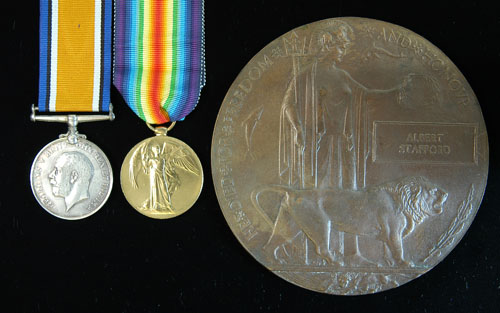
Auction: 6017 - Orders, Decorations, Campaign Medals & Militaria
Lot: 344
A Scarce Great War ´Q-Ship´ Casualty Pair to Ordinary Seaman A. Stafford, Q.27, Royal Navy British War and Victory Medals (J.60219 A. Stafford. Ord. R.N.), extremely fine, with Bronze Memorial Plaque ´Albert Stafford´ (3) Estimate £ 280-320Albert Stafford served during the Great War as an Ordinary Seaman in H.M.S. Warner (Q.27), and was killed in action, 13.3.1917, when she was sunk by U 38 west of Ireland, he is commemorated on the Royal Naval Memorial, Plymouth. An article on the sinking appeared in the Hamburg Nachrichten, which was reported in the Daily Express and on the 29th September in Fishing News, ´On a westward run from the coast, in order to lie in wait for the ships destined for England, one of our big U-boats, towards nine o´clock in the morning of a cold March day, sighted a smallish steamer of about 1,500 tons approaching with an eastward course, which excited remark not only by her high bridge and high deck erections, but also by the meaningless deviations from her route and her wild zig-zag course. The submarine put the last torpedo into the tube for the attack, and only now and again popped the conning-tower for a few moments above the surface, in order not to betray itself to the suspicious steamer, which was approaching at about twelve knots. In spite of the continuous change of course, it was possible to get the enemy within range, and the torpedo was launched without being noticed. It had scarcely penetrated, with a powerful detonation, into the centre of the steamer when she began to sink, and after a second explosion in the boiler-house, she disappeared in less than three minutes. The large number of the crew standing on deck, who only succeeded, in spite of the utmost exertions, in lowering one boat to the water, seemed to confirm the suspicion that this was a U-boat trap. In order to ascertain certainly if this were so, U_ _ [.38] went up to the survivors, who were drifting about in the water, and fished out six men, who were clinging half benumbed to planks. The men were very well dressed, and had a good military carriage to which one is not usually accustomed in mercantile ships. According to their statement, the steamer was bound from Africa to England. After denying it for a long time, they at last admitted that they belonged to the Navy. The sunk ship was, they said, the U-boat trap Q.27, H.M.S. Warner, and the Captain and all the officers had perished in the boiler explosion.´ (Q-Ships, Carson Ritchie, refers). The remainder of the survivors were picked up by the British Submarine D.3. two days after her sinking, and landed at Galway.
Sold for
£250




